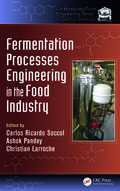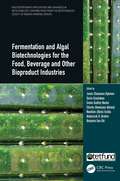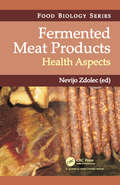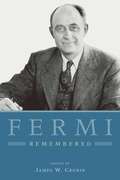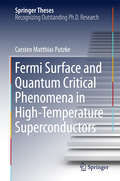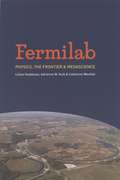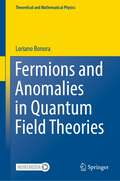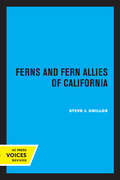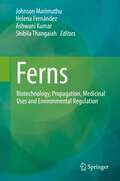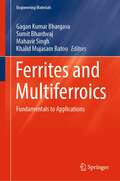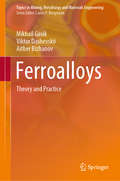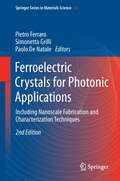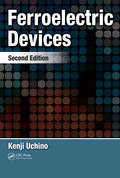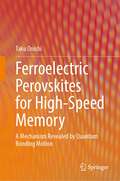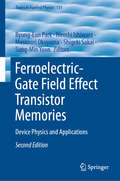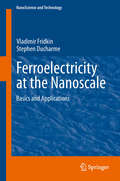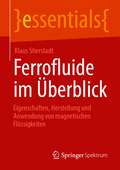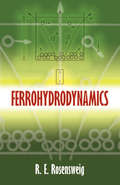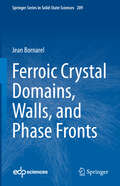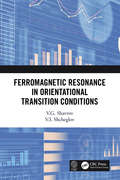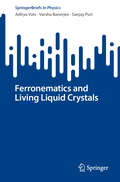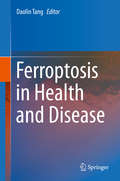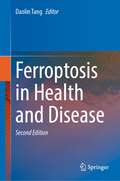- Table View
- List View
Fermentation Processes Engineering in the Food Industry (Contemporary Food Engineering)
by Carlos Ricardo Soccol Ashok Pandey Christian LarrocheWith the advent of modern tools of molecular biology and genetic engineering and new skills in metabolic engineering and synthetic biology, fermentation technology for industrial applications has developed enormously in recent years. Reflecting these advances, Fermentation Processes Engineering in the Food Industry explores the state of the art of
Fermentation and Algal Biotechnologies for the Food, Beverage and Other Bioproduct Industries (Multidisciplinary Applications and Advances in Biotechnology)
by James Chukwuma OgbonnaThis book covers a range of important topics on dairy and fermented foods and microalgae biotechnologies for food, beverage and bioproduct industries. The topics range from traditionally fermented African foods, fermentation technologies for large-scale industrial enzyme production to microalgae cultivation and nutraceuticals in Africa, etc. The editors provide detailed information on approaches towards harnessing indigenous bioresources for food and nutrition security, climate change adaptation, industrial enzyme production, environmental remediation and healthcare delivery. The book will be useful reference material for scientists and researchers working in the field of dairy and food biotechnology, fermentation technology, enzyme biotechnology, algal biotechnology and cultivation systems, biofuels and other bioproducts from algal biomass and underutilized and novel African food sources. Emphasizes recent advances in biotechnologies that could ameliorate the high-level global food insecurity through fermentation technologies applicable to traditional African indigenous and underutilized novel foods, algal biotechnology and value-added bioproducts Provides detailed information on how to harness indigenous bioresources including microalgae for food and nutrition security, climate change adaptation, industrial enzyme production, environmental remediation and healthcare delivery Introduces new frontiers in the area of large-scale enzyme production using fermentation biotechnologies and their applications in the food and beverage industries Discusses current biotechnologies applicable in the food, beverage and bioproduct industries James Chukwuma Ogbonna, Ph.D., is a Professor of Microbiology and Biotechnology, and Director, National Biotechnology Development Agency, South East Zonal Biotechnology Centre, University of Nigeria, Nsukka, Nigeria. Sylvia Uzochukwu, Ph.D., is a Professor of Food Science and Biotechnology, and Director, Biotechnology Centre, Federal University, Oye-Ekiti, Nigeria. Emeka Godfrey Nwoba, Ph.D., is a research scholar at the Algae Research & Development Centre, Murdoch University, Western Australia. Charles Oluwaseun Adetunji, Ph.D., is an Associate Professor of Microbiology and Biotechnology, and Director of Intellectual Property and Technology Transfer, Edo State University Uzairue, Nigeria. Nwadiuto (Diuoto) Esiobu, Ph.D., is a Professor of Microbiology and Biotechnology at Florida Atlantic University, Boca Raton, FL, USA, and the President and Founder of Applied Biotech Inc. and ABINL, Abuja, Nigeria. Abdulrazak B. Ibrahim, Ph.D., is a Capacity Development Expert at the Forum for Agricultural Research in Africa (FARA), and Associate Professor of Biochemistry, Ahmadu Bello University, Zaria, Nigeria. Benjamin Ewa Ubi, Ph.D., is a Professor of Plant Breeding and Biotechnology and Director, Biotechnology Research and Development Centre, Ebonyi State University, Abakaliki, Nigeria.
Fermented Meat Products: Health Aspects (Food Biology Series)
by Nevijo ZdolecThis book presents recent developments on the health and safety of fermented meat products. It discusses health aspects of select topics in fermented meat microbiology, veterinary public health, chemistry, technology, biotechnology, nutrition, toxicology, and quality assurance, and gives a broad insight into the product’s safety and health hazards. The book considers the safety of fermented meat products through a whole food chain approach. It focuses on requirements for strict hygienic and technological procedures to prevent potential risk during the production of ready-to-eat products. The book does not aim to serve as negative publicity for meat products. Just the opposite – it points out to the complexity of prevention and control of potential hazards/risks in the production which greatly contributes to a higher total value of fermented meat products. This reference book is a result of collaborative efforts of a number of distinguished authors with international reputation from renowned institutions and it is intended to both academic and professional audience.
Fermi Remembered
by James W. CroninNobel laureate and scientific luminary Enrico Fermi (1901-54) was a pioneering nuclear physicist whose contributions to the field were numerous, profound, and lasting. Best known for his involvement with the Manhattan Project and his work at Los Alamos that led to the first self-sustained nuclear reaction and ultimately to the production of electric power and plutonium for atomic weapons, Fermi's legacy continues to color the character of the sciences at the University of Chicago. During his tenure as professor of physics at the Institute for Nuclear Studies, Fermi attracted an extraordinary scientific faculty and many talented students—ten Nobel Prizes were awarded to faculty or students under his tutelage. Born out of a symposium held to commemorate the hundredth anniversary of Fermi's birth, Fermi Remembered combines essays and newly commissioned reminiscences with private material from Fermi's research notebooks, correspondence, speech outlines, and teaching to document the profound and enduring significance of Fermi's life and labors. The volume also features extensives archival material—including correspondence between Fermi and biophysicist Leo Szilard and a letter from Harry Truman—with new introductions that provide context for both the history of physics and the academic tradition at the University of Chicago. Edited by James W. Cronin, a University of Chicago physicist and Nobel laureate himself, Fermi Remembered is a tender tribute to one of the greatest scientists of the twentieth century. Contributors: Harold Agnew Nina Byers Owen Chamberlain Geoffrey F. Chew James W. Cronin George W. Farwell Jerome I. Friedman Richard L. Garwin Murray Gell-Mann Maurice Glicksman Marvin L. Goldberger Uri Haber-Schaim Roger Hildebrand Tsung Dao Lee Darragh Nagle Jay Orear Marshall N. Rosenbluth Arthur Rosenfeld Robert Schluter Jack Steinberger Valentine Telegdi Al Wattenberg Frank Wilczek Lincoln Wolfenstein Courtenay Wright Chen Ning Yang Gaurang Yodh
Fermi Remembered
by James W. CroninNobel laureate and scientific luminary Enrico Fermi (1901-54) was a pioneering nuclear physicist whose contributions to the field were numerous, profound, and lasting. Best known for his involvement with the Manhattan Project and his work at Los Alamos that led to the first self-sustained nuclear reaction and ultimately to the production of electric power and plutonium for atomic weapons, Fermi's legacy continues to color the character of the sciences at the University of Chicago. During his tenure as professor of physics at the Institute for Nuclear Studies, Fermi attracted an extraordinary scientific faculty and many talented students—ten Nobel Prizes were awarded to faculty or students under his tutelage. Born out of a symposium held to commemorate the hundredth anniversary of Fermi's birth, Fermi Remembered combines essays and newly commissioned reminiscences with private material from Fermi's research notebooks, correspondence, speech outlines, and teaching to document the profound and enduring significance of Fermi's life and labors. The volume also features extensives archival material—including correspondence between Fermi and biophysicist Leo Szilard and a letter from Harry Truman—with new introductions that provide context for both the history of physics and the academic tradition at the University of Chicago. Edited by James W. Cronin, a University of Chicago physicist and Nobel laureate himself, Fermi Remembered is a tender tribute to one of the greatest scientists of the twentieth century. Contributors: Harold Agnew Nina Byers Owen Chamberlain Geoffrey F. Chew James W. Cronin George W. Farwell Jerome I. Friedman Richard L. Garwin Murray Gell-Mann Maurice Glicksman Marvin L. Goldberger Uri Haber-Schaim Roger Hildebrand Tsung Dao Lee Darragh Nagle Jay Orear Marshall N. Rosenbluth Arthur Rosenfeld Robert Schluter Jack Steinberger Valentine Telegdi Al Wattenberg Frank Wilczek Lincoln Wolfenstein Courtenay Wright Chen Ning Yang Gaurang Yodh
Fermi Surface and Quantum Critical Phenomena of High-Temperature Superconductors
by Carsten Matthias PutzkeThis thesis provides a detailed introduction to quantum oscillation measurement and analysis and offers a connection between Fermi surface properties and superconductivity in high-temperature superconductors. It also discusses the field of iron-based superconductors and tests the models for the appearance of nodes in the superconducting gap of a 111-type pnictide using quantum oscillation measurements combined with band structure calculation. The same measurements were carried out to determine the quasiparticle mass in BaFe2(As1-xPx)2, which is strongly enhanced at the expected quantum critical point. While the lower superconducting critical field shows evidence of quantum criticality, the upper superconducting critical field is not influenced by the quantum critical point. These findings contradict conventional theories, demonstrating the need for a theoretical treatment of quantum critical superconductors, which has not been addressed to date. The quest to discover similar evidence in the cuprates calls for the application of extreme conditions. As such, quantum oscillation measurements were performed under high pressure in a high magnetic field, revealing a negative correlation between quasiparticle mass and superconducting critical temperature.
Fermilab: Physics, the Frontier, and Megascience
by Lillian Hoddeson Adrienne W. Kolb Catherine WestfallFermi National Accelerator Laboratory, located in the western suburbs of Chicago, has stood at the frontier of high-energy physics for nearly forty years. Since 1972, when the laboratory's original particle accelerator began producing the world's highest-energy protons for research, the government-supported scientific facility has been home to numerous scientific breakthroughs, including the discoveries of the top and bottom quarks. Fermilab is the first history of this laboratory and of its powerful accelerators told from the point of view of the people who built and used them for scientific discovery. Focusing on the first two decades of research at Fermilab, during the tenure of the laboratory's charismatic first two directors, Robert R. Wilson and Leon M. Lederman, the authors trace the rise of what they call "megascience," the collaborative struggle to conduct large-scale international experiments in a climate of limited federal funding. This dramatic period of innovation was shaped by an inevitable tension between Fermilab's pioneering ethos and the practical constraints of tightened budgets. Fermilab illuminates the growth of the modern research laboratory during the Cold War and captures the drama of human exploration at the cutting edge of science. It is essential reading for anyone interested in regional history, the history of physics, or institutional history.
Fermions and Anomalies in Quantum Field Theories (Theoretical and Mathematical Physics)
by Loriano BonoraThis book presents a modern view of anomalies in quantum field theories. It is divided into six parts. The first part is preparatory covering an introduction to fermions, a description of the classical symmetries, and a short introduction to conformal symmetry. The second part of the book is devoted to the relation between anomalies and cohomology. The third part deals with perturbative methods to compute gauge, diffeomorphism and trace anomalies. In the fourth part the same anomalies are calculated with non-perturbative heat-kernel-like methods. Part five is devoted to the family's index theorem and its application to chiral anomalies, and to the differential characters and their applications to global anomalies. Part six is devoted to special topics including a complete calculation of trace and diffeomorphism anomalies of a Dirac fermion in a MAT background in two dimensions, Wess-Zumino terms in field theories, sigma models, their local and global anomalies and their cancelation, and finally the analysis of the worldsheet, sigma model, and target space anomalies of string and superstring theories. The book is targeted to researchers and graduate students.
Ferns and Fern Allies of California (California Natural History Guides #16)
by Steve J. GrillosThis title is part of UC Press's Voices Revived program, which commemorates University of California Press’s mission to seek out and cultivate the brightest minds and give them voice, reach, and impact. Drawing on a backlist dating to 1893, Voices Revived makes high-quality, peer-reviewed scholarship accessible once again using print-on-demand technology. This title was originally published in 1966.
Ferns: Biotechnology, Propagation, Medicinal Uses and Environmental Regulation
by Helena Fernández Ashwani Kumar Johnson Marimuthu Shibila ThangaiahFerns are representative of genetic inheritance of great value as they include species of ancient vascular plants, which have direct connection with the evolution of plant life on Earth. This volume brings a selection of chapters covering a range of themes on fern biology, its development and growth, useful protocols for propagation and conservation purposes, genetic diversity, as well as medicinal and environmental applications.The content is organized into four parts: Biotechnology of Ferns Propagation of Ferns Ferns in Medicines Environmental Regulation This wide spectrum of the contributions provides quick access to information on the enormous potential of this plant group. This book brings together most recent research work and novel techniques, which is far from the traditional perspective usually followed. It is of interest to teachers, researchers, and botanists. Also the book serves as additional reading material for undergraduate and graduate students of agriculture, botany, forestry, and ecology.
Ferrites and Multiferroics: Fundamentals to Applications (Engineering Materials)
by Mahavir Singh Gagan Kumar Bhargava Sumit Bhardwaj Khalid Mujasam BatooThis book highlights the fundamentals of ferrites and multiferroic materials with special attention to their structure, types, and properties. It presents a comprehensive survey about ferrite and multiferroic materials, in areas significant to research and development in academia as well as in industry. The book discusses various types of methods applied for their synthesis and characterizations. This book is concerned with the fascinating class of materials with the promise for wide-ranging applications, including electromagnets, magnetic fluid hyperthermia, antenna applications, memory devices, switching circuits, bio-medical applications, actuators, magnetic field sensors and water purification, etc.
Ferroalloys: Theory and Practice (Topics in Mining, Metallurgy and Materials Engineering)
by Aitber Bizhanov Mikhail Gasik Viktor DashevskiiThis book outlines the physical and chemical foundations of high-temperature processes for producing silicon, manganese and chromium ferroalloys, alloys of molybdenum, vanadium, titanium, alkaline earth and rare earth metals, niobium, zirconium, aluminum, boron, nickel, cobalt, phosphorus, selenium and tellurium, iron-carbon alloys by carbon, silicone and aluminothermic methods. The chapters introduce the industrial production technologies of these groups of ferroalloys, the characteristics of charge materials, and the technological parameters of the melting processes. A description of ferroalloy furnaces is given in detail. Topics such as waste recycling, fines agglomeration technologies, and environmental issues are considered.
Ferroelectric Crystals for Photonic Applications
by Pietro Ferraro Simonetta Grilli Paolo De NataleThis book deals with the latest achievements in the field of ferroelectric domain engineering and characterization at micro- and nano-scale dimensions and periods. The book collects the results obtained in the last years by world scientific leaders in the field, thus providing a valid and unique overview of the state-of-the-art and also a view to future applications of those engineered and used materials in the field of photonics. The second edition covers the major aspects of ferroelectric domain engineering and combines basic research and latest updated applications such as challenging results by introducing either new as well as extended chapters on Photonics Crystals based on Lithium Niobate and Lithium Tantalate crystals; generation, visualization and controlling of THz radiation; latest achievements on Optical Parametric Oscillators for application in precise spectroscopy. Further more recent advancements in characterization by probe scanning microscopy and optical methods with device and technological orientation. A state-of-the-art report on periodically poled processes and their characterization methods are provided on different materials (LiNbO3, KTP) furnishing update research on ferroelectric crystal by extending materials research and applications.
Ferroelectric Devices: Research Misconceptions And Rectifications (Materials Engineering Ser.)
by Kenji UchinoUpdating its bestselling predecessor, Ferroelectric Devices, Second Edition assesses the last decade of developments—and setbacks—in the commercialization of ferroelectricity. Field pioneer and esteemed author Uchino provides insight into why this relatively nascent and interdisciplinary process has failed so far without a systematic accumulation of fundamental knowledge regarding materials and device development. Filling the informational void, this collection of information reviews state-of-the-art research and development trends reflecting nano and optical technologies, environmental regulation, and alternative energy sources. Like the first edition, which became a standard in the field, this volume provides a general introduction to ferroelectrics with theoretical background. It then addresses practical design and device manufacturing, including recently developed processes and applications. Updating old data with a forecast of future developments, the text analyzes improvements to original ferroelectric devices to aid the design process of new ones. The second edition includes new sections on: Pb-free piezoelectrics Size effect on ferroelectricity Electrocaloric devices Micro mass sensor Piezoelectric energy harvesting Light valves and scanners Multi-ferroic devices, including magneto-electric sensors Uchino provides a general introduction to the theoretical background of ferroelectric devices, practical materials, device designs, drive/control techniques, and typical applications. He presents frequently asked questions from students, lab demonstrations for practical understanding, and "check point" quizzes and model solutions to monitor understanding. After a thorough exploration of ferroelectric devices and their past, this book looks to the industry’s future, assessing market size and remaining reliability/lifetime issues. The author also unveils his strategy for developing "best-selling" ferroelectric devices.
Ferroelectric Perovskites for High-Speed Memory: A Mechanism Revealed by Quantum Bonding Motion
by Taku OnishiThis book is intended for theoretical and experimental researchers who are interested in ferroelectrics and advanced memory. After introducing readers to dielectric, perovskites, advanced memories, and ferroelectric, it explains quantum simulation. Then, using molecular orbital calculation results, it explains the ferroelectric mechanism in perovskite titanium oxides in concrete terms. Lastly, the book examines the materials designed for high-performance ferroelectrics and discusses the future of high-speed memory.
Ferroelectric Polymers: Chemistry: Physics, and Applications
by Hari Singh NalwaThis work covers the chemistry and physics of polymeric materials and their uses in the fields of electronics, photonics, and biomedical engineering. It discusses the relationship between polymeric supermolecular structures and ferroelectric, piezoelectric and pyroelectric properties.
Ferroelectric-Gate Field Effect Transistor Memories: Device Physics and Applications (Topics in Applied Physics #131)
by Byung-Eun Park Hiroshi Ishiwara Masanori Okuyama Shigeki Sakai Sung-Min YoonThis book provides comprehensive coverage of the materials characteristics, process technologies, and device operations for memory field-effect transistors employing inorganic or organic ferroelectric thin films. This transistor-type ferroelectric memory has interesting fundamental device physics and potentially large industrial impact. Among various applications of ferroelectric thin films, the development of nonvolatile ferroelectric random access memory (FeRAM) has been most actively progressed since the late 1980s and reached modest mass production for specific application since 1995. There are two types of memory cells in ferroelectric nonvolatile memories. One is the capacitor-type FeRAM and the other is the field-effect transistor (FET)-type FeRAM. Although the FET-type FeRAM claims the ultimate scalability and nondestructive readout characteristics, the capacitor-type FeRAMs have been the main interest for the major semiconductor memory companies, because the ferroelectric FET has fatal handicaps of cross-talk for random accessibility and short retention time. This book aims to provide the readers with development history, technical issues, fabrication methodologies, and promising applications of FET-type ferroelectric memory devices, presenting a comprehensive review of past, present, and future technologies. The topics discussed will lead to further advances in large-area electronics implemented on glass, plastic or paper substrates as well as in conventional Si electronics. The book is composed of chapters written by leading researchers in ferroelectric materials and related device technologies, including oxide and organic ferroelectric thin films.
Ferroelectricity at the Nanoscale
by Vladimir Fridkin Stephen DucharmeThe investigation of nanosized ferroelectric films and ferroelectric nanocrystals has attracted much attention during the past 15 - 20 years. There is interest in the fundamental and applied aspects. The theoretical basis is connected with the development of the Landau-Ginzburg-Devonshire (LGD) mean field and the first principles theories to the ultrathin ferroelectric films with thickness in the vicinity of critical size. Important potential applications are possible nanosize ferroelectric films in non-volatile memories, microelectronics, sensors, pyroelectric and electro-optic devices. This new area of research of ferroelectricity is still in impetuous development and far from completion. Many topics elucidated need generalization. The book contains theory and experimental data for a wide range of ferroelectric materials.
Ferrofluide im Überblick: Eigenschaften, Herstellung und Anwendung von magnetischen Flüssigkeiten (essentials)
by Klaus StierstadtDieses essential führt in das Gebiet der magnetischen Flüssigkeiten ein. In der Natur kommen sie nicht vor, aber in der Technik und in der Medizin dienen sie zu vielen nützlichen Zwecken. Diese Flüssigkeiten werden in aufwändigen Verfahren hergestellt und sind daher nicht billig zu haben. Ihre rheologischen Eigenschaften können mit relativ schwachen Magnetfeldern verändert und gesteuert werden. In der Technik dienen sie als Dichtungs- und Schmiermittel sowie für Pumpen, Kupplungen und Bremsen. In der Medizin werden sie zur Krebsbekämpfung und als bildgebende Kontrastmittel verwendet. Eine Substanz wie diese, die gleichzeitig flüssig und stark magnetisch ist, besitzt ein großes Anwendungspotenzial auf vielen verschiedenen Gebieten.
Ferrohydrodynamics (Dover Books on Physics)
by R. E. RosensweigThe behavior and dynamics of magnetic fluids receive a coherent, comprehensive treatment in this high-level study. One of the best classical introductions to the subject, the text covers most aspects of particle interaction, from magnetic repulsion to quasi-stable equilibriums and ferrohydrodynamic instabilities. Suitable for graduate students and researchers in physics, engineering, and applied mathematics.
Ferroic Crystal Domains, Walls, and Phase Fronts (Springer Series in Solid-State Sciences #209)
by Jean BornarelThis book explores ferroic crystals, focusing on the intricate relationship between their macroscopic properties and microscopic phenomena. Ferroic materials, characterized by hysteresis cycles that link magnetization, polarization, and deformation to their respective fields, are pivotal in understanding and advancing various technological applications. For the first time, this volume presents experimental evidence directly linking macroscopic responses to microscopic interface phenomena—domains, domain walls, and phase fronts—offering unprecedented clarity into the inner workings of ferroic systems. Simultaneous observations of domains, susceptibility measurements, and gamma diffractometry reveal how these microscopic structures govern the shape and coercive fields of hysteresis cycles, especially at first-order phase transitions. The book bridges the gap between macroscopic measurements and nanoscopic insights, highlighting how domain interactions influence susceptibility through both short- and long-range effects, including freezing processes, isolated walls, and events occurring within the walls themselves. It further demonstrates how domain wall interactions—often overlooked in theoretical models—play a critical role in the reversal of ferroic order parameters. Special attention is given to the interplay between ferroelasticity and ferroelectricity, delving into energy dynamics, phase transitions, and thermodynamic models. Notably, the manipulation of chemical, mechanical, and electrostatic energies in first-order transitions is shown to affect the shape of phase fronts, which may appear as planes, &“factory roof&” geometries, or even fractal patterns, and may include periodic inclusions of one phase in another. With clear explanations, visual demonstrations, and practical experimental insights, the book caters to researchers and students aiming to deepen their understanding of these phenomena. Designed for both seasoned scientists and budding researchers, it integrates experimental data, simulation results, and theoretical models to provide a holistic understanding of ferroic crystals, their behaviors, and their applications in modern science and technology.
Ferromagnetic Resonance in Orientational Transition Conditions
by V.G. Shavrov V.I. ShcheglovThe unique properties of ferromagnetic resonance (FMR) in magnetodielectric solids are widely used to create highly efficient analog information processing devices in the microwave range. Such devices include filters, delay lines, phase shifters, non-reciprocal and non-linear devices, and others. This book examines magnetic resonance and ferromagnetic resonance under a wide variety of conditions to study physical properties of magnetodielectric materials. The authors explore the properties in various mediums that significantly complicate magnetic resonance and provide a summary of related advances obtained during the last two decades. It also covers the emergence of new branches of the spectrum and anomalous dependencies on the magnetic field. Key Features: Reviews basic principles of the science of crystallographic symmetry and anisotropic solid-state properties Addresses the inhomogeneous nature of the distribution of the magnetization in the material being studied Explains the mathematic methods used in the calculation of anisotropic solids of a solid Provides the reader with a path to substitute electromagnetic waves when magnetostatic apparatus prove insufficient
Ferronematics and Living Liquid Crystals (SpringerBriefs in Physics)
by Sanjay Puri Aditya Vats Varsha BanerjeeThis book delves into the intricate world of soft matter physics, specifically focusing on two contemporary complex systems: ferronematics and living liquid crystals. These systems amalgamate passive and active inclusion in the nematic liquid crystals. From a pedagogical description to advanced dynamics, this book provides a solid foundation for understanding these complex systems. Practical insights through simulations and analytical expressions bridge the gap between theory and real-world applications, making the knowledge gained highly relevant. This book caters to students, researchers, and scholars in the field of soft matter physics. A strong foundation in statistical physics and mathematical physics is recommended, especially in areas related to liquid crystal physics, statistical mechanics and complex systems. The book provides a plethora of theoretical knowledge, simulations, and analytical expressions, serving as an indispensable resource for those eager to delve into the intriguing domains of soft matter physics.
Ferroptosis in Health and Disease
by Daolin TangThis book sheds new light on ferroptosis, as an only recently recognised form of regulated cell death. Its respective chapters address the numerous implications that ferroptosis can have for virtually all aspects of metabolism. They also share insights on the morphological characterisation of ferroptosis and highlight the different pathways of induction. Accordingly, the book offers a unique perspective on a mechanism that is involved in a multitude of pathologies, including cancer cell death, neurotoxicity, neurodegenerative diseases, acute renal failure, drug-induced hepatotoxicity, tissue ischemia/reperfusion injury, and T cell immunity. Readers will learn in which cell types this form of regulated cell death is likely to occur, and how it can be pharmacologically influenced, making the book a fascinating and informative read not only for scientists working in cell biology, but also for clinicians in the field of cancer research.
Ferroptosis in Health and Disease
by Daolin TangThis updated and expanded volume gives new insights on ferroptosis – an iron-dependent form of non-apoptotic cell death. The collection of chapters discusses the two major pathways through which ferroptosis can occur: the extrinsic or transporter-dependent pathway and the intrinsic or enzyme-regulated pathway.Readers will gain an understanding of the multiple levels, on which this special cell death is regulated. Hence, the contributions will take a closer look at epigenetic, transcriptional, posttranscriptional and posttranslational layers. Among the described regulators and transcription factors are GPX4, ACSL4 and NFE2L2. This edited volume collects reviews related to current knowledge on the integrated molecular machinery of ferroptosis, thereby also describing how dysregulated ferroptosis is involved in human diseases.
